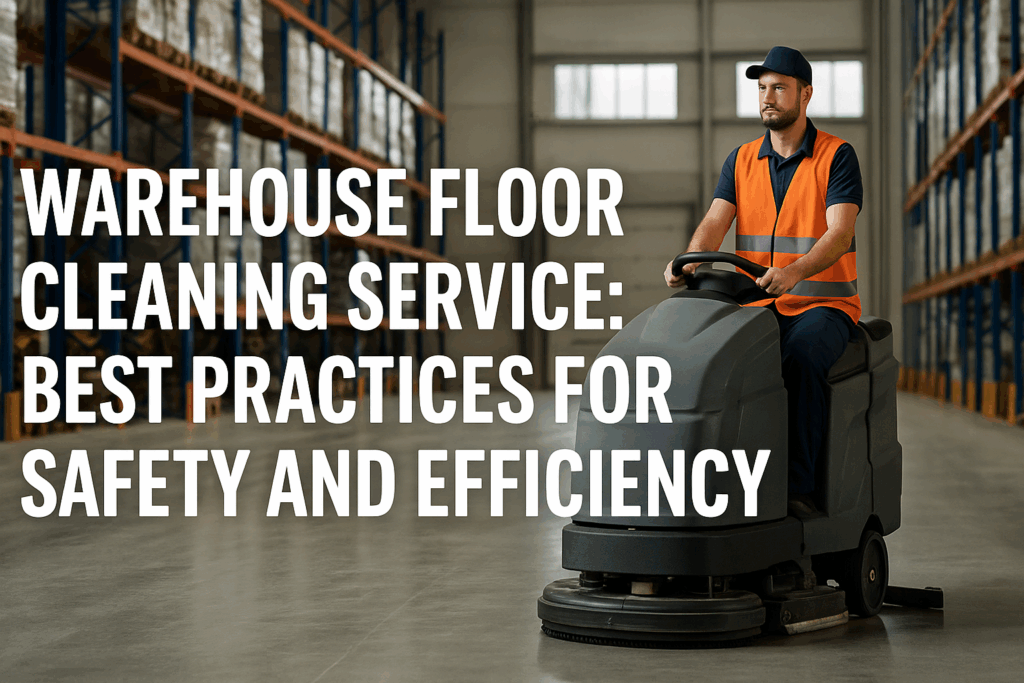
A warehouse is more than just a storage space. It’s a workplace that supports logistics, manufacturing, inventory handling, and day-to-day operations. For this reason, keeping warehouse floors clean is about safety, efficiency, and the long-term durability of the facility. Slippery surfaces, dust buildup, and spills can lead to injuries, product damage, or operational downtime. That’s where a professional warehouse floor cleaning service becomes essential.
This guide explores best practices for cleaning and maintaining warehouse floors, answers common questions, highlights the right cleaning methods for different floor types, and provides insight into how expert providers like TCS Floors help facilities maintain safe, clean, and durable environments.
Why Warehouse Floor Cleaning Matters
Warehouse floors do more than provide a surface for storage and movement, as they directly impact safety, efficiency, and how a facility is perceived. Regular cleaning is not just about appearances; it plays a key role in protecting employees, preserving flooring investments, and maintaining professional standards.
- Safety and Accident Prevention: Warehouse environments often involve heavy machinery, forklifts, and constant foot traffic. Dust, grease, or spilled liquids on floors can cause slips or equipment malfunctions. A proper cleaning program reduces workplace hazards and supports OSHA compliance.
- Prolonged Floor Lifespan: Concrete, epoxy, and other industrial flooring materials require upkeep. Dirt and debris act like sandpaper, gradually wearing down coatings or polishing. Regular cleaning preserves surface integrity and reduces costly repairs.
- Productivity and Efficiency: A clean floor minimizes dust that can interfere with equipment, scanners, and packaging systems. Workers also move more efficiently in a well-maintained environment, and the facility operates at a higher standard of professionalism.
- Customer and Regulatory Perception: Warehouses often undergo audits from clients, partners, or regulatory agencies. Clean floors reflect operational discipline and reliability.
Best Practices for Warehouse Floor Cleaning
| Best Practice | Details | Examples / Notes |
| Establish a Cleaning Schedule | Frequency depends on traffic, product type, and machinery use. High-traffic areas need more frequent service. | – Daily scrubbing for distribution centers.- Weekly cleaning for low-traffic storage. |
| Use the Right Equipment | Match equipment to cleaning needs for efficiency and effectiveness. | – Scrubbers: Wide areas and heavy buildup.– Sweepers: Dust and light debris.– Wet/Dry Vacuums: Spills and liquids.– Degreasers: Oily or greasy spots. |
| Choose the Proper Technique | Apply methods based on the type of dirt and desired finish. | – Dry Sweeping: Loose dust and debris.– Wet Scrubbing: Deep cleaning for grime.– Chemical Cleaning: Stains and grease.– Polishing: Maintain shine and smooth finish. |
| Train Staff or Hire Professionals | Ensure consistent cleaning by training employees or outsourcing for specialized care. | – Staff handle daily upkeep.- Professionals provide deep cleaning with advanced tools. |
Industrial Floor Scrubbing in Detail
The backbone of most warehouse cleaning programs is industrial floor scrubbing. Walk-behind scrubbers are ideal for narrow aisles and congested areas, while ride-on machines cover large docks and wide aisles quickly. Some facilities benefit from combination sweeper-scrubbers that handle both debris and wet soil in a single pass. Choosing the right machine depends on the warehouse layout and soil load.
Pads and brushes also matter. Softer pads are best for polished surfaces, while medium pads handle everyday cleaning. Tougher stains may require green pads or brushes, though heavy-duty black pads should be avoided on coatings or polished floors. Down-pressure, solution flow, and squeegee angle all affect results. Too much pressure can damage coatings, while too little solution smears dirt instead of lifting it. Regular maintenance of squeegees and recovery tanks ensures equipment leaves a dry, streak-free path.
Chemicals and Safety
Chemistry plays an important role in effective cleaning. Neutral cleaners are safe for routine maintenance and leave minimal residue. Alkaline detergents handle oils and general soils but should be followed with a rinse. Heavy-duty degreasers lift hydraulic fluids and stubborn stains but must be used sparingly to avoid damaging finishes. In food-related facilities, enzymatic cleaners work well on organic soils, provided they are given proper dwell time.
Operators should always follow dilution guidelines. Over-concentration leads to sticky floors and wasted product, while under-dosing reduces effectiveness. Safety measures include labeling secondary containers, keeping SDS sheets accessible, and providing proper personal protective equipment for staff.
Setting Frequencies by Zone
Not all areas need the same cleaning schedule. Inbound docks experience the heaviest soil load and often require scrubbing after every shift. Main traffic aisles may need daily cleaning in high-volume facilities, while racked storage aisles can be scrubbed two or three times per week. Pick and pack zones generate corrugate dust and usually require daily sweeping and frequent scrubbing. Battery rooms demand daily spot cleaning and multiple scrubs per week, along with neutralizing any acid spills. Offices, break rooms, and restrooms should be cleaned daily to maintain hygiene standards.
Seasonal factors also affect frequency. Snowy winters and rainy seasons bring in more soil, requiring increased dock and entryway cleaning. Well-placed mats at entrances can reduce tracked-in debris, but frequencies often need to rise during these periods.
Costs and Equipment
| Category | Details | Cost Range / Notes |
| Service Costs | Based on square footage, soil type, and provider vs. in-house cleaning. | – One-time deep cleans: Priced per sq. ft. – Large open spaces: lower rate. – Tight/high-soil areas: higher rate. – Recurring contracts: Often billed by time block or frequency. |
| Walk-Behind Scrubbers | Suitable for smaller to mid-size spaces. | Several thousand dollars. |
| Ride-On Scrubbers | Efficient for large facilities with wide open areas. | Tens of thousands of dollars. |
| Combination Sweeper-Scrubbers | Handle grit, oils, and debris in one pass; improve efficiency. | Higher cost than standard scrubbers; premium investment. |
| Burnishers | Used mainly for polished concrete to maintain shine. | Less costly compared to scrubbers; secondary piece of equipment. |
| Consumables | Pads, brushes, squeegees, detergents, water treatment, and replacement parts. | Ongoing expense; must be factored into operating budget. |
| Battery Maintenance | Extending battery life reduces replacement costs and downtime. | Proper charging routines help cut long-term costs. |
Choosing the Right Provider
Selecting a warehouse floor cleaning service is not just about finding someone who can sweep and scrub, as it’s about ensuring safety, extending floor life, and keeping operations efficient. A poorly chosen provider can lead to inconsistent results, higher long-term costs, and even safety violations. The right partner, however, will act as an extension of your operations team, aligning their services with your facility’s unique needs.
Industry Experience
Work with providers who have documented experience in warehouses of similar size, layout, and industry. A provider familiar with food-grade storage will know the sanitation standards required, while one accustomed to high-traffic distribution centers will understand the frequency and equipment needed. Ask for examples of past projects, including details about the scale and challenges involved.
Equipment Capability
Not all cleaning fleets are the same. Ensure the provider’s machines are capable of handling your floors, whether that means ride-on scrubbers for large open areas, degreasing systems for oil-prone sections, or specialized sweepers for dusty environments. Confirm whether they maintain backup equipment to prevent downtime in case of mechanical failure.
Safety and Compliance
Cleaning in a warehouse setting requires strict adherence to OSHA and facility-specific guidelines. Reputable providers will share their chemical safety data sheets (SDS), dilution ratios, and operator training protocols. Their crews should be trained in lockout/tagout procedures, PPE use, and safe handling of cleaning chemicals.
Client References
References from other warehouse clients can provide valuable insight into reliability and service quality. Ask specifically about response times, issue resolution, and whether results were consistent over time. Peer feedback often reveals how well a provider adapts to real-world challenges.
Trial Periods
Before signing a long-term contract, test the provider in one or two zones. A trial allows you to evaluate not only the quality of the cleaning but also how they communicate, schedule, and report results. This limited engagement reduces risk and builds confidence in the partnership.
Data and Reporting
Providers who document their work show greater accountability. Request reports that include before-and-after photos, down-pressure settings, chemical usage, and machine run times. This data-driven approach ensures repeatable quality and helps you compare performance across service cycles.
Spotlight on TCS Floors

TCS Floors specializes in warehouse and industrial floor cleaning, offering tailored services that prioritize safety, efficiency, and durability. Their programs cover all aspects of warehouse floor cleaning, including dust and debris removal, tire mark treatment, and degreasing.
For facilities seeking to extend floor life, TCS offers commercial concrete floor coatings. These coatings not only improve appearance but also create surfaces that resist chemicals, reduce dust, and simplify ongoing maintenance.
As one of the established commercial floor cleaning companies, TCS Floors brings a warehouse-first approach. They match machine sizes to aisle geometry, schedule work to minimize downtime, and provide clear reporting with photos and recommendations. Whether you need a one-time deep clean or a recurring maintenance program, TCS Floors ensures that your facility stays safe and efficient.
Advanced Trends in Warehouse Cleaning
The warehouse cleaning industry is evolving quickly, driven by technology, safety, and sustainability goals. Facility managers are seeking solutions that not only improve cleanliness but also reduce costs, labor demands, and environmental impact. These advancements are shaping the future of floor care and helping warehouses operate with greater efficiency and accountability.
Automation and Robotics
Robotic scrubbers are becoming increasingly common in large facilities. They follow pre-programmed routes, deliver consistent cleaning, and require minimal human input. This allows staff to focus on higher-value tasks while ensuring that floors are maintained on schedule without lapses in coverage.
Green Cleaning Solutions
Companies are adopting environmentally friendly cleaning products that minimize chemical exposure for employees and reduce water usage. These solutions align with corporate sustainability initiatives and often meet LEED or other green building standards. They also help improve indoor air quality and reduce long-term wear on flooring materials.
IoT-Enabled Monitoring
Modern scrubbers and cleaning systems are now equipped with IoT sensors that provide real-time performance data. Facility managers can track machine usage, chemical consumption, water levels, and maintenance needs from a central dashboard. This visibility ensures accountability, prevents breakdowns, and supports data-driven decisions.
Advanced Dust Control Systems
Dust control has moved beyond simple sweeping. New systems are designed to capture airborne particles before they resettle, improving air quality and protecting sensitive equipment like scanners and conveyors. This not only keeps floors cleaner but also contributes to a healthier and more efficient workplace.
Conclusion
A professional warehouse floor cleaning service is about more than appearances. It safeguards employees, extends the life of expensive flooring, and keeps operations running efficiently. From industrial floor scrubbing to concrete floor cleaning for warehouses, the right program sets a safer, cleaner, and more productive tone across the facility.
For companies ready to take floor care seriously, TCS Floors offers the expertise, equipment, and coatings that transform cleaning from a reactive task into a proactive strategy. Clean floors are safer floors, and safer floors keep your warehouse moving.
FAQs
The most effective method starts with dry sweeping to remove dust, grit, and pallet debris. Once the surface is clear, use an industrial auto-scrubber with the right pads or brushes and a cleaning solution matched to the floor type. Stubborn stains, oils, or tire marks should be pre-treated with a degreaser before scrubbing. Always finish with complete water recovery so the floor dries quickly and is safe for traffic.
“In-floor cleaning system” usually refers either to permanent wash-down drains or robotic scrubber fleets. Built-in drains and trench systems are treated as construction projects, and costs vary widely depending on plumbing, interceptors, and code requirements—often tens of thousands of dollars. Robotic scrubbers with docking stations typically start in the $10,000–$30,000 range per unit. Actual costs depend on facility size, soil type, and how much automation is desired.
Warehouse cleaning is the process of removing dust, spills, oils, and debris from floors and adjacent areas to maintain safety and efficiency. It involves sweeping, industrial floor scrubbing, spot-degreasing, and sometimes sealing or polishing depending on the floor type. The goal is to reduce slip hazards, protect equipment, and keep work areas compliant with safety standards. A strong program sets schedules by zone so high-traffic areas get cleaned more often.
The machines commonly used in warehouses are called industrial floor scrubbers or auto-scrubbers. Larger facilities may use ride-on scrubbers, while narrow aisles often require walk-behind versions. Some machines combine sweeping and scrubbing in a single pass, known as sweeper-scrubbers. In addition, burnishers are used on polished concrete to restore shine, and wet/dry vacuums handle spills and detail work.


